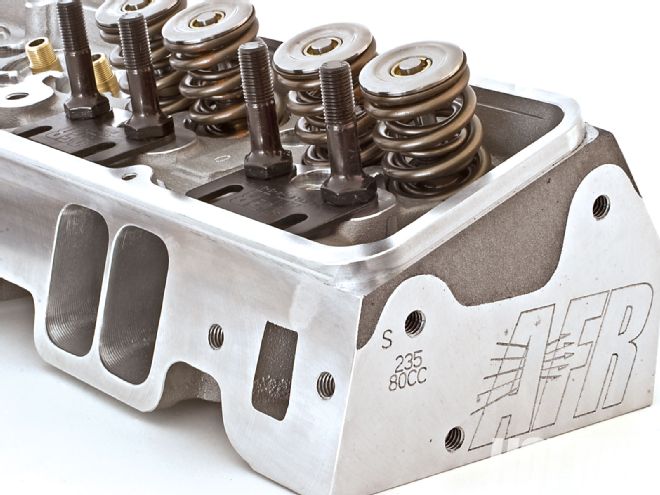
With the advent of relatively affordable aftermarket blocks, Gen I small-block Chevy displacements have been growing ever larger. It used to be a 406 was considered a big small-block. But nowadays a 434 is a popular hot street/strip package, and there are even 454ci crate small-block packages available. That's big-block territory-so it stands to reason that a head with big-block-like flow characteristics is needed to keep up with all those cubes, one that would be as compatible as possible with existing mass-produced small-block Chevy parts to keep costs under control.
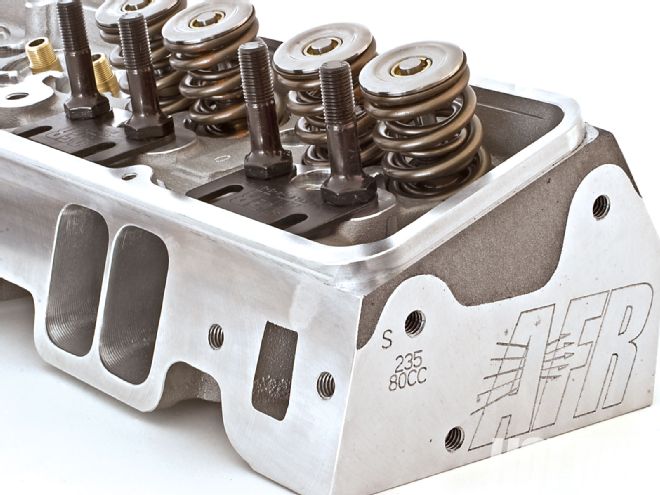
Ports Of Haul
Enter the Air Flow Research (AFR) 235cc Eliminator, the highest-flowing mass-produced small-block Chevy head yet that still maintains the original intake port location and 23-degree valve angles. AFR invested hundreds of hours developing its current port and chamber designs, as well as optimizing the multiangle valve job that's critical for tying everything together. The old 23-degree race head benchmark was around 300 cfm-but the new port flows about 13 percent or a staggering 40 cfm better. And despite the large runner volume, there's no midrange flow sacrifice. The heads reach 270 cfm by 0.400-inch lift and 300 cfm by 0.500. This should enable hot rodders to make good power without going off the deep end on cams.
Although the intake side is the most critical for generating good power, AFR certainly did not ignore the exhaust side. There is at least 235 cfm available by 0.500-inch lift and just under 260 cfm by 0.750.
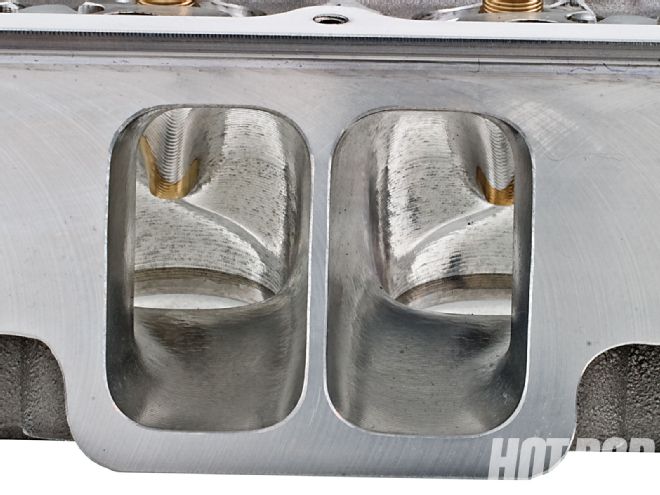 AFR has put everything it's learned over the last five years into the new intake port (shown here). The heads are delivered completely CNC-ported. As delivered, the intake flowed 341 cfm at 0.800-inch lift on Joe Sherman's SuperFlow bench-yet existing standard intake manifolds bolt right up using a 2.180- x 1.310-inch intake gasket (such as Fel-Pro PN 1206).
AFR has put everything it's learned over the last five years into the new intake port (shown here). The heads are delivered completely CNC-ported. As delivered, the intake flowed 341 cfm at 0.800-inch lift on Joe Sherman's SuperFlow bench-yet existing standard intake manifolds bolt right up using a 2.180- x 1.310-inch intake gasket (such as Fel-Pro PN 1206).
Eliminator 235s come with 1.550-inch-od dual springs with 225 pounds on the seat that can support up to 0.710-inch-lift solid-roller cams. Upgrades are optionally available. The head's spread valve centerlines require AFR's proprietary guideplates, set up for 5/16-inch pushrods. The heads bolt on using standard head gaskets and head bolts or studs.
Inside The Chambers
The 235 is available with 70 cc (PN 1130) or 80 cc (PN 1132) chambers. A special 70cc, spread-exhaust-port version for long-duration oval-track or marine use carries PN 1134. Spreading the ports enhances cooling under sustained high-rpm running but doesn't improve flow; it's not needed for other apps. All variations can be flat-milled to 65 cc or angle-milled to 60 cc.
A 1.60-inch exhaust valve remains standard, but the in-take is now a big 2.125 inches. Accommodating the big intake while preventing excessive cylinder-bore shrouding required relocating the valve centerlines as well as offsetting the centerlines themselves closer to the exhaust side. AFR uses the popular 60/40 offset: The exhaust is moved about 0.060 inch closer to the wall; the enlarged intake gets moved 0.040 inch away from its adjacent wall. This greatly enhances average flow at the expense of slight flow losses on the extreme low end. AFR says custom-built small-blocks typically won't need a piston swap as most modern aftermarket pistons already have oversize valve reliefs to accommodate the increasingly popular shift.
Obviously, the rule won't hold true on a stock short-block with replacement-style pistons or even a ZZ4-but these heads aren't intended for a mild engine. Although they should clear a 4.030-inch bore (with a contour on the top of the cylinder to match the chamber outline), realistically they work best on 4.125-inch-or-larger bore sizes. At a minimum, that would be a classic 400 (4.125 bore x 3.75 stroke) or the increasingly popular, high-revving 377 (4.125 x 3.48).
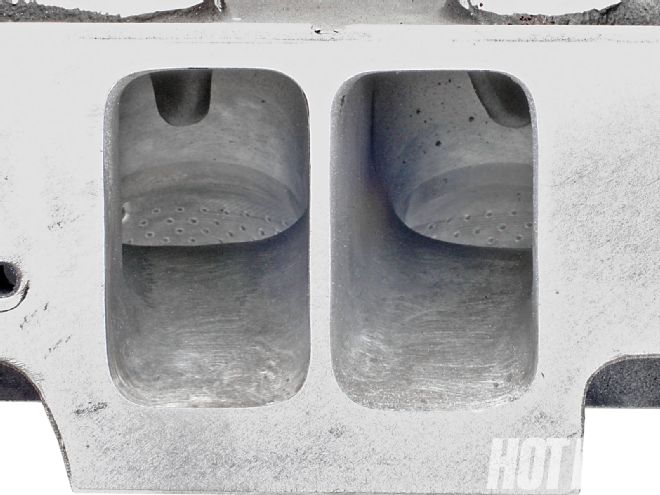 Achieving this level of performance formerly took a heavily reworked raised-runner design, like Sherman's head used for this article's dyno comparo (shown here).
Achieving this level of performance formerly took a heavily reworked raised-runner design, like Sherman's head used for this article's dyno comparo (shown here).
Putting Them To The Test
The Eliminator 235 has sufficient flow capacity to support about 700 hp on a single four-barrel, normally aspirated, 91-octane-fuel engine. But what about a no-holds-barred, Sportsman-level setup equipped with twin carbs, a tunnel-ram, and a crankcase evacuation pump? Longtime Chevy engine builder Joe Sherman recently evaluated a set of the new 235 Eliminators on a 14.5:1 400ci drag engine equipped with a huge Comp Cams mechanical roller (intake/exhaust specs: 289/304 degrees duration at 0.050, 0.849/0.729 lift with 1.75/1.55:1 rockers, 109-degree lobe separation, and 106-degree intake centerline).
The new heads were compared against a set of 5-year-old AFR 215cc 23-degree heads with raised intake runners. No longer sold by AFR, the old heads were really a cheater design for certain racing classes; although advertised at 215 cc, even out of the box they were much larger. And Sherman had about 100 hours of hand porting in the old castings that increased intake runner volume to 255 cc. The 215 did have smaller 2.100-inch intake valves, but its raised runners offered a straighter shot to the bowl area with a theoretically superior short-turn radius. The Edelbrock Victor Ram intake used by Sherman for these tests is designed for standard, nonraised-runner heads, so Sherman had to fabricate 3/16-inch-thick aluminum adapter plates to mate it to the old 215 heads.
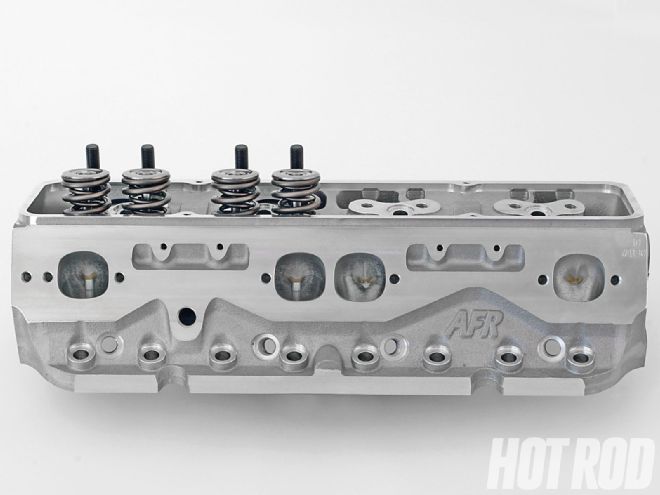 The new heads' exhausts flowed 256 cfm at 0.800 lift. Like many performance heads, the runners are raised 0.250 inch, but AFR says that shouldn't impact most header fitment. The standard port-spacing version shown here takes normal small-block header flanges with at least 1 3/4-inch primaries; 1 7/8-inch-or-larger tubes are preferred for optimum performance.
The new heads' exhausts flowed 256 cfm at 0.800 lift. Like many performance heads, the runners are raised 0.250 inch, but AFR says that shouldn't impact most header fitment. The standard port-spacing version shown here takes normal small-block header flanges with at least 1 3/4-inch primaries; 1 7/8-inch-or-larger tubes are preferred for optimum performance.
Both heads were tested with Sherman's dual (no damper) PAC springs (PN 1324) that can support up to 0.880-inch lift (they ought to with 275 pounds on the seat and 800 pounds open). The springs were treated for reduced fatigue loss and were used with PAC's ultralight titanium retainers (PN 1324).
Both old and new heads made about the same top-end power: 812 and 813 hp, respectively. The top-end falloff over 8,000 rpm was a tad less for the old 215s, but the 235s generated significant improvements below 7,400, yielding 31.7 lb-ft more torque at the observed peaks. Anytime a smaller port can generate equal or better power and torque numbers in comparison with a larger port (despite any flow number discrepancies), it indicates higher velocity and inertia for superior cylinder packing.
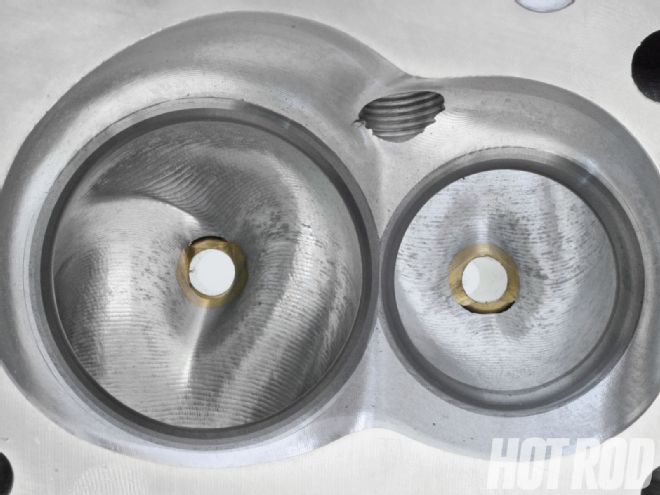 The 235's intake port has an LS7-like vane near the valveguide, with the overall chamber and port reshaped to complement it. The result, says AFR, is a more efficient port with some swirl benefits as well. AFR is adding the vane to all its higher-end small-block Chevy heads. Note how the spark plug is angled toward the exhaust side to keep it out of the intake wash.
The 235's intake port has an LS7-like vane near the valveguide, with the overall chamber and port reshaped to complement it. The result, says AFR, is a more efficient port with some swirl benefits as well. AFR is adding the vane to all its higher-end small-block Chevy heads. Note how the spark plug is angled toward the exhaust side to keep it out of the intake wash.
Sherman says he has about $6,000 worth of porting labor in the old heads on top of the $3,500 AFR used to get for the raised-runner 215 castings. Air Flow Research sells a pair of fully assembled Eliminator 235s for just $2,225. This means the 235s achieve better overall performance for about $7,275 less. If you have lots of cubes or a big-bore, high-revving Mouse motor and want maximum performance as well as maximum backward compatibility with existing 23-degree components, they deserve serious consideration.